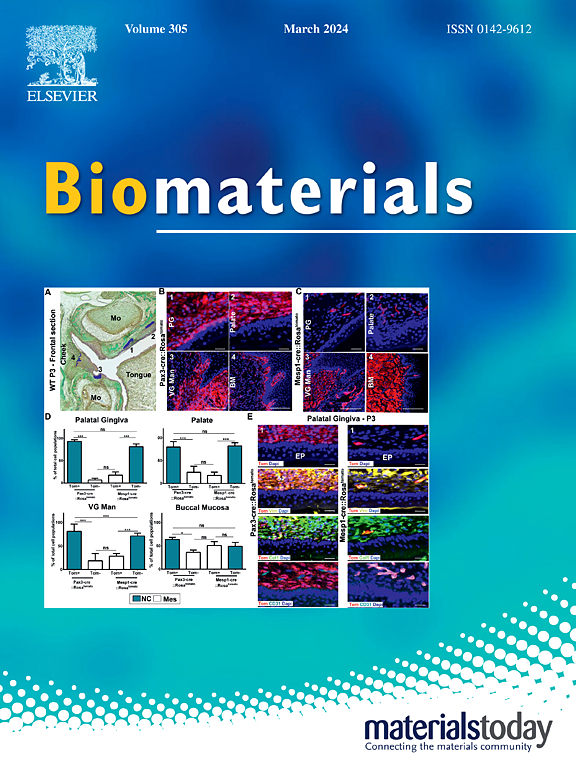A soft-hard hybrid scaffold for osteochondral regeneration through integration of composite hydrogel and biodegradable magnesium
IF 12.9
1区 医学
Q1 ENGINEERING, BIOMEDICAL
引用次数: 0
Abstract
Osteochondral injuries are prevalent and difficult to treat in clinical practice. Traditional tissue engineering typically results in poor integration at the calcified cartilage interlayer, since they cannot address different needs from the cartilage and the supporting subchondral bone. This study presents a hybrid biological scaffold integrating soft and hard components to systematically adopt to osteochondral regeneration. The upper section consists of bioactive hydrogel, kartogenin (KGN), and bone marrow stromal cells (BMSCs), replicating mechanical properties and chondrogenic potential of nature hyaline cartilage. The lower section utilizes a biodegradable metal magnesium (Mg) alloy scaffold with customized porous structure, providing mechanical response comparable to trabecular bone, along with regulated degradation and enhanced angiogenesis and osteogenesis. The bioactive hydrogel is compressed into the pores of Mg scaffold. Notably, the unique combination not only significantly improves mechanical response and fatigue resistance of the cartilage section but also maintains interface stability throughout the repair process. Accordingly, the hybrid scaffold effectively promotes the regeneration of both cartilage and subchondral bone simultaneously by upregulation of osteogenic and chondrogenic specific genes. Overall, this work provides valuable insights for treating osteochondral injuries by material–structure–function integrated strategies.
复合水凝胶与可生物降解镁结合制备软硬复合骨软骨再生支架
骨软骨损伤是临床上常见且治疗困难的疾病。传统的组织工程通常导致钙化软骨间层的整合不良,因为它们不能满足软骨和支撑软骨下骨的不同需求。本研究提出一种软硬结合的复合型生物支架系统应用于骨软骨再生。上半部分由生物活性水凝胶、kartogenin (KGN)和骨髓基质细胞(BMSCs)组成,复制了天然透明软骨的力学特性和成软骨潜能。下半部分采用定制多孔结构的可生物降解金属镁(Mg)合金支架,提供与小梁骨相当的机械响应,同时调节降解,增强血管生成和成骨。生物活性水凝胶被压缩到镁支架的孔隙中。值得注意的是,这种独特的组合不仅显著提高了软骨截面的力学响应和抗疲劳性,而且在整个修复过程中保持了界面的稳定性。因此,混合支架通过上调成骨和软骨特异性基因,同时有效促进软骨和软骨下骨的再生。总之,这项工作为材料-结构-功能一体化策略治疗骨软骨损伤提供了有价值的见解。
本文章由计算机程序翻译,如有差异,请以英文原文为准。
求助全文
约1分钟内获得全文
求助全文
来源期刊

Biomaterials
工程技术-材料科学:生物材料
CiteScore
26.00
自引率
2.90%
发文量
565
审稿时长
46 days
期刊介绍:
Biomaterials is an international journal covering the science and clinical application of biomaterials. A biomaterial is now defined as a substance that has been engineered to take a form which, alone or as part of a complex system, is used to direct, by control of interactions with components of living systems, the course of any therapeutic or diagnostic procedure. It is the aim of the journal to provide a peer-reviewed forum for the publication of original papers and authoritative review and opinion papers dealing with the most important issues facing the use of biomaterials in clinical practice. The scope of the journal covers the wide range of physical, biological and chemical sciences that underpin the design of biomaterials and the clinical disciplines in which they are used. These sciences include polymer synthesis and characterization, drug and gene vector design, the biology of the host response, immunology and toxicology and self assembly at the nanoscale. Clinical applications include the therapies of medical technology and regenerative medicine in all clinical disciplines, and diagnostic systems that reply on innovative contrast and sensing agents. The journal is relevant to areas such as cancer diagnosis and therapy, implantable devices, drug delivery systems, gene vectors, bionanotechnology and tissue engineering.
 求助内容:
求助内容: 应助结果提醒方式:
应助结果提醒方式:


